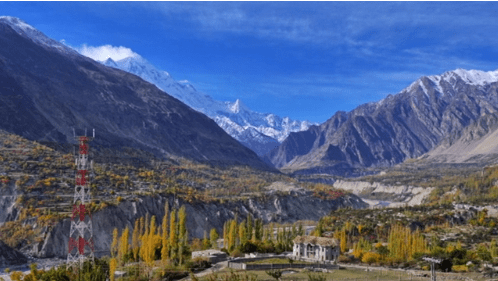Ahmedabad village in the remote Hunza valley of northern Pakistan generates more electricity than its households can use – a rare situation in this energy starved region.
The village in Gilgit-Baltistan is home to Pakistan’s first community owned and operated private power company selling electricity from micro hydropower plants using funds from the UN Clean Development Mechanism (CDM).
Also watch video: Small dams bring power to Pakistan’s mountain communities
The mountains of Gilgit-Baltistan have some of the steepest gradients in the world. Glacier melt water tumbles down slopes and cuts through valleys and human habitations, providing sustenance for agriculture. But more recently, these waters have become gold for energy generation.
Over the past twenty years, the Aga Khan Rural Support Programme (AKRSP) has worked with mountain communities to build 23 micro hydropower plants in Gilgit-Baltistan – all owned and operated by local community organisations.
“The Germans and Swiss have already perfected mountain hydropower technology, but AKRSP adapted it to the rugged Karakoram landscape and for local manufacture and community based operation,” said Muzaffaruddin, former senior manager at AKRSP.
When the Pakistan government ratified the Kyoto protocol in 2005 – which established global greenhouse gas emissions reduction targets, AKRSP was quick to access money under the UN Clean Development Mechanism Development Mechanism (CDM), to scale up the region’s hydropower capacity. The CDM allows rich countries to offset emissions by funding sustainable development initiatives in poorer countries.
AKRSP proposed a plan to generate up to 15 MW of power from numerous small hydropower plants and set up private utility companies which could sell excess power elsewhere. However, the CDM stipulates it will provide 50% of project costs if the beneficiary community contributes 20%.
Hunza’s Ahmedabad community was the first to rise to this challenge. “We felt that every household in the village could afford to sell one cow or six poplar trees which would raise US$3,000 to match 30% of the total project cost– which is what we did,” said Habibullah, president of the community organisation.
AKRSP mobilised the remaining 30% from the Acumen fund and a national poverty alleviation facility grant.
The project was registered in 2009 with the UNFCC and the German government provided technical assistance.
A 200 KW hydropower plant is now up and running in Ahmedabad. The Ahmedabad Power Utility Company sells electricity to its own village, neighbouring settlements, commercial businesses and hotels in Karimabad, the tourist centre of Hunza, as well as the Chinese road construction company repairing the Karakoram Highway. A women’s carpentry enterprise and restaurant also use power from Ahmedabad’s community hydropower company.
This is Pakistan’s first community owned and operated private power company. Its share holders are all local villagers who have drawn up their own company rules and regulations. No member can own less than two shares or more than four shares: this allows even the poorest widow in the village a stake in this profitable enterprise. The collective has also decided to reinvest profits back into the company for three years in order to enable company development and sustainability.
Hydropower has brought a number of benefits to the village: reduced deforestation and emissions from diminished use of petrol fuels and an improvement in biodiversity. People also say night time illumination in homes has allowed children to study longer; families in this part of Pakistan see education as the best investment for the future. Women appreciate time spent on household chores has been freed up by electric devices such as washing machines.
At night, surplus electricity is used to pump glacier melt water from the villages up the mountainside to irrigate plantations of popular, mulberry and olive trees, intercropped with alfalfa used for fodder.
We carried out research in 2013 in the Hunza valley, with field visits to the Ahmedabad Power Utility Company, interviews with senior management of key institutions including Aga Khan, officials from the Ministry of Climate Change and other experts.
Recipe for success
From our analysis of what made this community power company so successful, three factors stand out. First, the leadership shown by AKRSP made excellent strategic use of CDM. This leadership pushed the limits of governance boundaries although in the process it encountered many obstacles, for example, difficulties in securing loans. The government was also slow to respond to the need to provide private power distribution services.
Second, technological innovation was used to adapt German turbine technology to the mountain environment and install stabilising devices for local conditions.
Third, financial innovation met UNFCCC requirements and combined community investment with international grants and loans.
Over ten years the Ahmedabad project has evolved – the community now operates a successful and hydropower plant and sells electricity to neighbouring areas. In this way, an international carbon finance mechanism has been able to reduce global greenhouse gas emissions and improve the quality of life for rural families.
The authors of this paper are the founding member of the Karakoram Research Institute for understanding social and ecological change in the Gilgit- Baltistan region of Pakistan.
